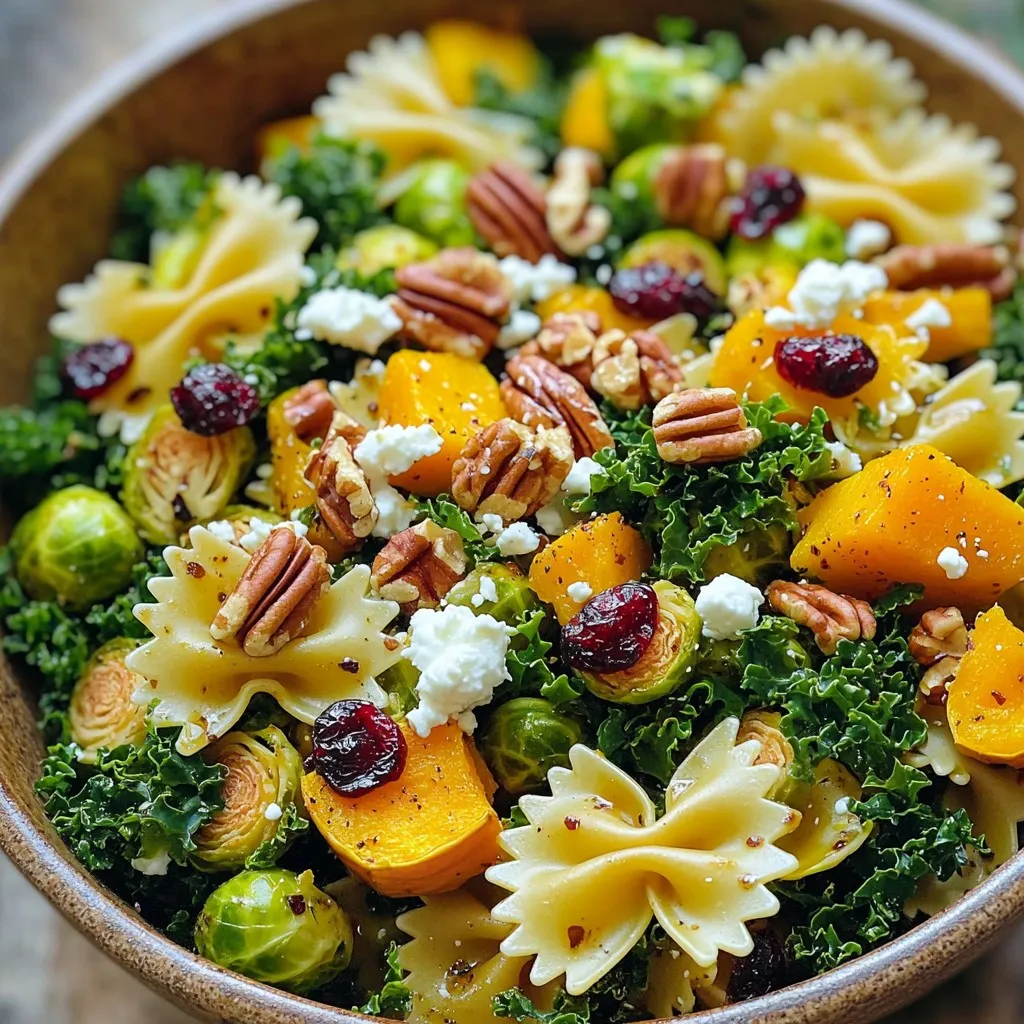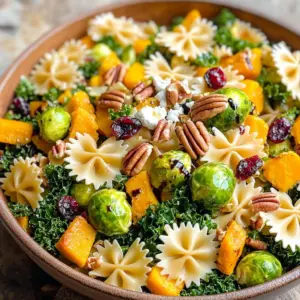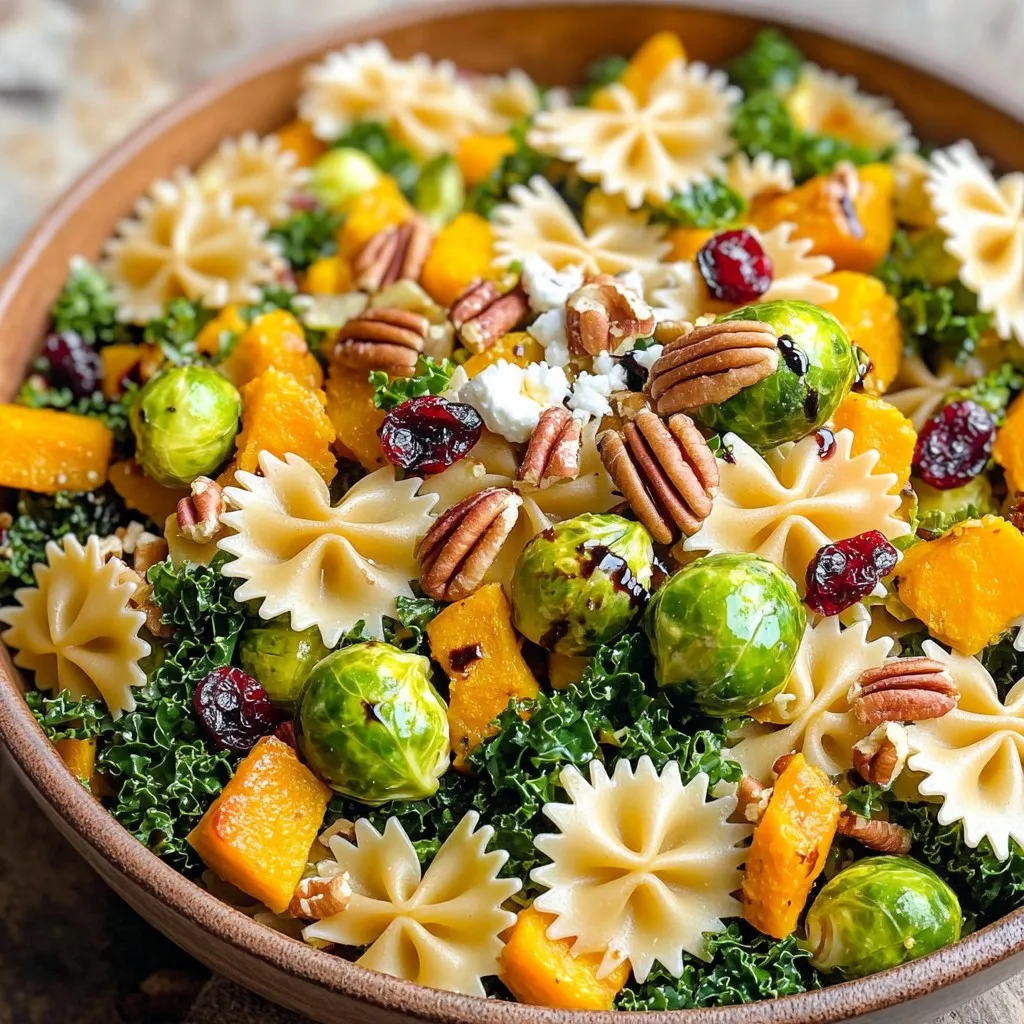Fall brings a burst of color and flavor, which is why I love making a Fall Harvest Pasta Salad. This dish combines fresh, seasonal veggies, wholesome pasta, and creamy cheese for a delightful flavor explosion. You’ll find easy steps to roast vegetables perfectly and mix everything together with a simple dressing that highlights autumn’s best tastes. Get ready to savor a vibrant, fresh dish that’s perfect for any gathering!
Ingredients
Main Ingredients
– 12 oz pasta (preferably farfalle or penne)
– 1 cup butternut squash, diced into small cubes
– 1 cup Brussels sprouts, trimmed and halved
– 1 cup kale, stems removed and chopped
– 1/2 cup dried cranberries for a burst of sweetness
– 1/2 cup pecans, roughly chopped for crunch
– 1/4 cup feta cheese, crumbled for creaminess
The main ingredients in this pasta salad bring rich flavors and textures. The pasta forms the base, giving a great bite. Seasonal vegetables like butternut squash and Brussels sprouts add sweetness and a slight crunch. The kale offers a fresh note, while dried cranberries provide a pop of color and sweetness. Pecans add a lovely crunch, and feta gives a creamy finish.
Dressing Components
– 1/3 cup extra-virgin olive oil
– 2 tablespoons apple cider vinegar
– 1 tablespoon pure maple syrup for sweetness
– 1 teaspoon Dijon mustard for a tangy kick
– Salt and freshly ground black pepper to taste
The dressing is simple yet full of flavor. Extra-virgin olive oil provides healthy fat, making the salad rich. Apple cider vinegar adds a tangy note, balancing the sweetness from the maple syrup. Dijon mustard enhances the flavor with its sharpness. Don’t forget to season with salt and pepper to bring everything together. This dressing perfectly complements the vibrant ingredients.
Step-by-Step Instructions
Preparing the Vegetables
Preheating the Oven
Start by preheating your oven to 400°F (200°C). This heat helps to caramelize the vegetables, making them sweet and tasty.
Roasting Process
On a large baking sheet, spread out 1 cup of diced butternut squash and 1 cup of halved Brussels sprouts. Drizzle them with 1/3 cup of extra-virgin olive oil. Season with salt and freshly ground black pepper. Toss them well to coat. Roast the vegetables for 25-30 minutes. They are ready when they are fork-tender and nicely caramelized.
Cooking the Pasta
Boiling Instructions
While the vegetables roast, bring a pot of salted water to a boil. Add 12 oz of pasta, preferably farfalle or penne. Cook the pasta according to the package instructions until al dente.
Cooling the Pasta
Once done, drain the pasta and rinse it under cold water. This step cools the pasta down and keeps it from becoming mushy.
Combining Ingredients
Mixing Vegetables and Pasta
In a large mixing bowl, combine the cooled pasta, roasted butternut squash, Brussels sprouts, 1 cup of chopped kale, 1/2 cup of dried cranberries, and 1/2 cup of roughly chopped pecans. Stir gently to mix everything well.
Preparing the Dressing
For the dressing, whisk together 1/3 cup of olive oil, 2 tablespoons of apple cider vinegar, 1 tablespoon of pure maple syrup, and 1 teaspoon of Dijon mustard in a small bowl. Add a pinch of salt and pepper, and blend until smooth. Pour the dressing over the pasta salad and toss carefully to coat all ingredients.
Tips & Tricks
Perfecting Roasting Techniques
Achieving Optimal Flavor
Roasting brings out the sweet and rich flavors in vegetables. Start with fresh, in-season produce like butternut squash and Brussels sprouts. Cut them into small, even pieces. This helps them cook evenly. Drizzle with olive oil and season well with salt and pepper. Roast until they are golden and tender. This usually takes about 25-30 minutes at 400°F.
Timing for Vegetables
Roast your vegetables first. This allows them to cool slightly before mixing. You want the vegetables to be warm, not hot, when you add them to the pasta. If you roast them too early, they may cool down too much.
Dressing Adjustments
Balancing Sweetness and Acidity
Your dressing should have a nice balance of sweet and tangy flavors. Use apple cider vinegar and maple syrup in the right amounts. This mix gives the salad a fresh taste. If you like it sweeter, add more maple syrup. If you prefer it tangy, add more vinegar.
Customizing Flavor Profiles
Feel free to adjust the dressing to suit your taste. You can add garlic for a punch or herbs like thyme or rosemary for extra flavor. Just remember to mix well to combine all the flavors.
Presentation Ideas
Serving Suggestions
Serve your pasta salad in a large, decorative bowl. This makes it look inviting. For a special touch, you can use a platter.
Garnishing Tips
Add extra crumbled feta cheese on top for creaminess. A sprinkle of chopped pecans adds crunch. For a finishing touch, drizzle a little balsamic glaze over the salad. This adds a nice shine and flavor, making it even more appealing.

Variations
Ingredient Swaps
Alternative Vegetables
You can change the vegetables in this salad to suit your taste. Try using sweet potatoes instead of butternut squash. They add a nice sweetness. You can also swap Brussels sprouts for roasted carrots. Their natural sweetness works well. For a crunch, add bell peppers or snap peas. They bring freshness and color.
Different Cheese Options
Cheese adds creaminess to the salad. If you prefer a different taste, use goat cheese instead of feta. Goat cheese has a tangy flavor that fits well with the other ingredients. You can also skip the cheese for a lighter dish. Nutritional yeast can give you a cheesy flavor without dairy.
Dietary Adjustments
Vegan Version
To make this salad vegan, simply remove the cheese. Use a vegan dressing made with tahini or avocado. These options add creaminess without dairy. You can also add chickpeas for extra protein. They make the salad filling and nutritious.
Gluten-Free Options
If you need a gluten-free version, choose gluten-free pasta. There are many types available today. Quinoa or lentil pasta are great choices. They provide a different texture and flavor, making the salad unique. Just make sure to check the label for gluten-free ingredients.
Storage Info
Best Practices for Refrigeration
Storing leftovers from your Fall Harvest Pasta Salad is easy. Start by letting it cool to room temperature. Transfer the salad to an airtight container. Make sure to remove as much air as possible to keep it fresh. The salad can last in the fridge for up to three days.
– Container Recommendations: Choose glass or BPA-free plastic containers. Glass is sturdy and doesn’t stain. Plastic is lighter and easier to store. If you have a large batch, divide it into smaller containers for quick snacks.
Freezing Guidelines
You can freeze pasta salad, but it may change texture. To freeze, make sure the salad is fully cooled. Place it in a freezer-safe container. Leave some space for expansion. Seal it tightly and label it with the date. The salad can last in the freezer for up to two months.
– How to Freeze Pasta Salad: Portion out the salad into smaller servings. This makes it easier to thaw only what you need. Avoid freezing any added cheese or dressing. They do not freeze well and may become watery.
– Thawing and Reheating Tips: To thaw, place the container in the fridge overnight. If you’re in a rush, you can use the defrost setting on your microwave. After thawing, give it a good stir. Taste it and adjust the seasoning if needed.
FAQs
Can I prepare this salad in advance?
Yes, you can make this salad a day ahead. I suggest you wait to add the dressing until just before serving. This keeps the pasta and veggies fresh. You can store it in the fridge for up to three days. Just be sure to keep the feta separate if you want it to stay creamy.
What are the best seasonal vegetables to use?
For a fall harvest salad, think about using:
– Butternut squash
– Brussels sprouts
– Kale
– Sweet potatoes
– Carrots
These veggies add color and flavor. They also provide nutrients that support your health during the colder months.
How do I make a lighter dressing?
To lighten up the dressing, try these tips:
– Use less olive oil and more vinegar.
– Swap maple syrup for a splash of lemon juice.
– Mix in Greek yogurt for creaminess without extra calories.
These changes keep the dressing tasty while cutting down on calories.
This post detailed how to create a delicious pasta salad. We explored key ingredients like seasonal vegetables, nuts, and cheese. I provided step-by-step instructions for preparing vegetables, cooking pasta, and mixing everything together. You learned tips on roasting and dressing adjustments. I shared variations for dietary needs and storage guidelines for leftovers.
In closing, these insights help make pasta salad easy and fun. Enjoy experimenting with flavors and using fresh ingredients. Your next meal will benefit from this knowledge.

